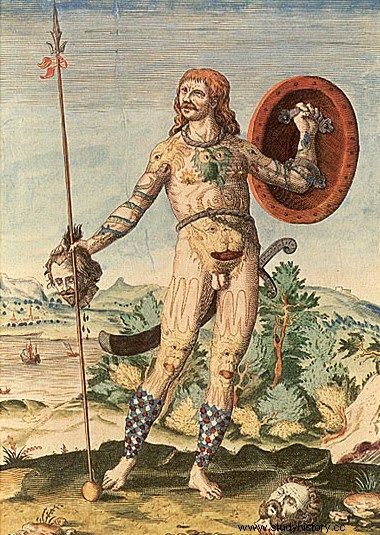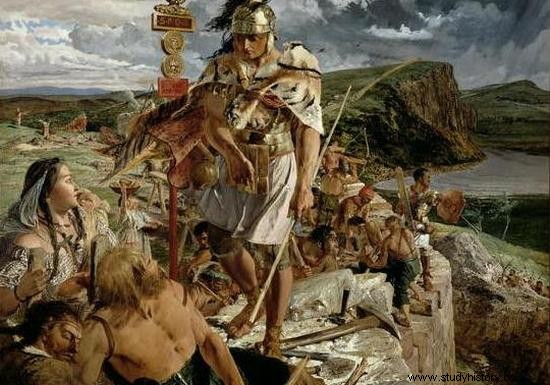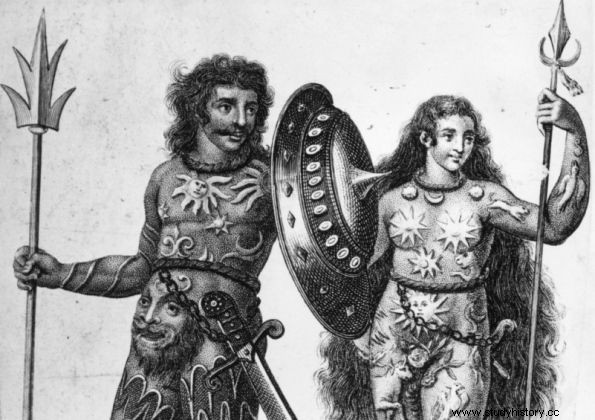History books have accustomed us to male succession and primogeniture (inheritance by the firstborn). This is the case in the oldest ruling dynasty - the Japanese imperial family - where only men inherit, and even in the Principality of Monaco, where primogeniture is mandatory. In the past, however, it happened that the ladies had priority. Where? At the dangerous and strange Picts.
Picts do not function in the mind of an ordinary bread eater. If anything, instead of in history textbooks, they appear somewhere in the background of a Hollywood movie or in the plot of a novel set in medieval Britain. Characteristics? War symbols tattooed (or painted) on the face, most often in blue or navy blue. Sword in hand (their metallurgy was at a very high level). Lots of nudity (the Picts were supposed to move naked to the fight, in the movies they are rather dressed at least partially) and a furious battle cry.

… And Mr. Pikt.
There is also a second option:Picts-Stealers. Poor Roman legionaries march frightened through one of Britain's dense forests. Suddenly, these terrible Picts emerge from the fog, their counts kill half of the military and in this fog they disappear, leaving the bleeding Romans to their fate. We are gadu gadu here, and Hollywood mush took over - it's time to deal with it.
Where exactly did the Picts come from?
It is not known for certain where the Picts actually came from. Modern scientists are lost in conjecture on this subject, drawing their knowledge from a very limited number of sources. It's hard to say when exactly they settled in Britain and where they came from, but the oldest records about them come from the second half of the 1st century AD. Among other things, it was against the Picts that the famous Hadrian's Wall was supposed to protect the Roman property.
The Roman historian Cassius Dio cites a handful of information about the Caledons in his "Roman History". According to historians, this is where the Picts come from. After the legionaries - due to the coloring of the face and the painting of patterns on the body - began calling the Caledonian warriors pictu (painted Latin), the Picts suddenly appeared on the source cards.

The Picts aroused such fear in the Romans that the Emperor Hadrian ordered the construction of a wall of nearly 120 kilometers that would separate the warlike tribe from the conquered Britain. The illustration shows a painting by John Clayton showing the construction of Hadrian's Wall (source:public domain).
But let's go back to Dion and his knowledge of this mysterious people. In the book "Forgotten nations of Europe" Jerzy Strzelczyk summarizes his statements as follows:
Thanks to the abovementioned history we learn some new details about the Caledons, about the custom of painting bodies and scant clothing, about weapons consisting mainly of swords, small shields and spears, about the lack of helmets and armor, war chariots, about the method of fighting based on a quick attack and an equally quick (simulated) retreat into forests and swamps, about the lack of cities, breeding and hunting as the basis of food (while their lands abounded in fish, fishery was allegedly not of great importance ) […].
The features mentioned by Dion - individually or several at once - can also be found in other peoples. The Picts differed in more than just having them all at once.
Because only the mother is always sure
A long time ago, polygamy reigned in the land of the Picts. It was then legal and… willingly cultivated. Under such conditions, fidelity was passé, and establishing paternity impossible . The clever Picts have figured out how to fix this.

The Picts did not bother with the paternity issue at all (source:public domain).
Instead of bothering about establishing paternity each time, they decided to focus on matrilinealism (inheriting from the maternal line of kinship and the affiliation of the offspring to the so-called mother's group). Although the Picts did not know the Latin legal sentence mater semper certa est (Latin mother is always sure), they used her in their system and women were given the right to power.

After adopting Christianity (as a result of the mission of Bishop Ninian), the Picts had to abandon polygamy. After all, is it fitting for a godly Christian to eat "bread" from many ovens? In any case, although it was already possible to apply the above-mentioned Latin sentence in its entirety (the second part of it reads pater est, quem nuptiae demonstrrant , i.e. the father is the one indicated by the marriage union), the old custom was followed. Therefore, the marriages of the sisters and daughters of the Pictish rulers were very important. Women transferred the rights to the throne through them to foreign courts (if such a term could be used for the early Middle Ages). Thus, claims to rule over the Picts could theoretically be made by various rulers married to Pictish princesses, from communities or peoples following the patriarchy. Besides, more than once foreigners sat on Pict thrones.
For many gentlemen, brought up in the spirit of patrilinealism, the system of inheritance of rights in the female line had to be a bitter pill. Yet in all known Pict history we find only two instances of father-to-son passing of the throne - both occurring in a declining period. This is called attachment to tradition!
Source0:
Trivia is the essence of our website. Short materials devoted to interesting anecdotes, surprising details from the past, strange news from the old press. Reading that will take you no more than 3 minutes, based on single sources. This particular material is based on:
- Jerzy Strzelczyk, The Forgotten Nations of Europe , Ossolineum, Wrocław 2009.
